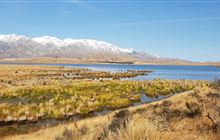Wetlands
Introduction
Wetlands are areas where water is the primary factor controlling the environment and associated plant and animal life.What is a wetland?
Wetlands are areas where water is the primary factor controlling the environment and associated plant and animal life. They can be freshwater or estuarine (located at the coast with brackish water) or both!
Wetlands are where the water table is at or near the surface of the land, or where the land is permanently or temporarily (as with the tides) covered by water. Although once thought of as mosquito-filled swamps or bogs, wetlands actually perform many valuable functions.
Wetlands act like the kidneys of the earth, cleaning the water that flows into them. They trap sediment and soils, filter out nutrients and remove contaminants; can reduce flooding and protect coastal land from storm surge; are important for maintaining water tables; they also return nitrogen to the atmosphere.
In the past, those soggy areas of land were often drained and 'put to better use' but now we know they are essential and one of the world's most productive environments. In New Zealand they support the greatest concentration of wildlife out of any other habitat.
Threats to wetlands
Human activity provides most threats to New Zealand's remaining wetlands. Threats include:
- sand and gravel extraction causes changes in water levels, damages existing vegetation and provides access for weeds
- reclamation of lake and river margins, lagoons and estuaries, and draining of farm swamps, reduces wetland areas
- pollution by excess run-off of sediment and nutrients from farmlands
- plant and animal pest invasion
- stock grazing in wetlands and surrounding catchments damages vegetation, decreases soil stability and contributes to pollution
- careless recreation practices, including misuse of jet-skiing, hunting, kayaking, power boating and whitebaiting, disturbs plant and animal life and may destroy parts of the physical wetland environment
- forest harvesting close to wetlands may damage wetland vegetation and cause erosion
- loss of vegetation in surrounding catchments allow excess sediment to run directly into wetlands
- pine forests draw water away from ground water systems leaving depleted supplies, and poorly managed farming practices cause sediment and/or fertiliser run-off
- wetland drainage for urban or rural development.








